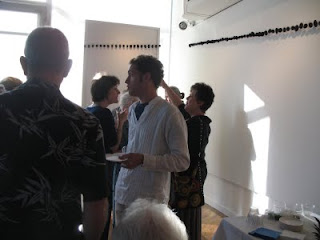The followings are some questions from my former students. I think it is good to share information because some of you might have similar problems.
"I have a couple of questions for you, Akemi. When I create more paste resist work on silk, 1) what weight and type of silk do you like best, what wears well? I saw some nice silk broadcloth at the SDA conference, from Exotic silks, that looks good, a nice even weave, good weight and 2) the silk that I used for our workshop is still a bit stiff from the paste, do I have to wash it more to remove it, or can I leave it as is? Would it last longer if I washed it? I also wonder if it would gum up my sewing machine too, if I don’t get all of it out? 3) do you use anything to seal the fabric, like Scotchguard spray?" from Valerie Bashaw
1. Recently I use silk organza. It can be applied 2 or more layers to print at the same time. I like medium weight of sateen. Wool & silk blend also work beautifully. Row silk doesn't work.
2. Stiffness comes from starch of rice paste (sweet rice flour). Dip in a warm water to remove starch. Be careful! If color comes out, take out the fabric immediately and put it in a cold water. Repeat. Then apply vinegar or hair conditioner. It makes soft. It was not enough rinsing if the fabric is stiff.
3. I don't seal the fabric. I asked to be framed when the art work placed in a dinning hall.
"when you prepare stencil with paint do you put net down after paint is on and still wet because I put paint down on top of net and it seems like net picks up a tiny bit of paint so it is not as clean Also I do see how different silks pick up resist patterns in different way but I am having trouble getting the clarity that I got in class hard to get the right balance of back round color so the piece pops any suggestions" from Elizabeth Jenkins
1. Do you mean "paint" as color rice paste? I don't exactly understand the situation. If so, the net side is up. Press slightly harder. So, color rice paste goes through the net. If paste is hard, it leaves a net mark on the fabric.
2. You are right. Depending on fabric, the impression is very different. Therefore, I use it as a metaphor. I interlaced sateen silk and hand woven row silk on my art work. It shows different colors based on "different (cultural) back grounds.
In addition to silk, choosing colors, thickness, combination of colors, etc. makes impression different. I think it makes the image richer and more interesting.
Suggestions: -Use one type of silk for a while. You will get familiar of the silk.
-Limit your color pallet, maybe 6~8 colors. If some colors are too aggressive, mix small amount of dark color or black to tone down.
-Keep color sample and recipe.







